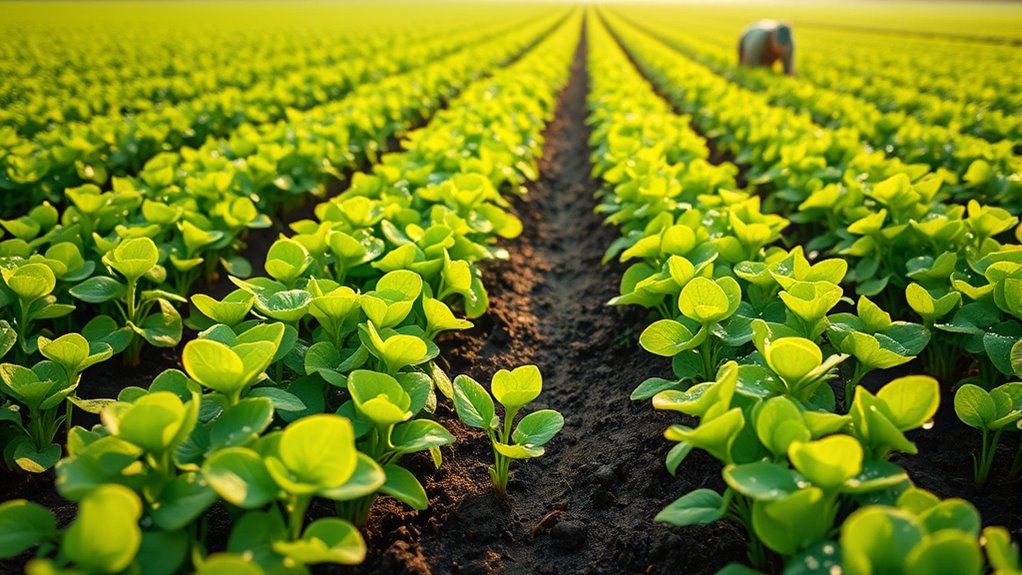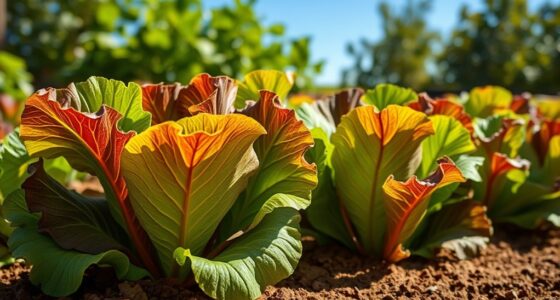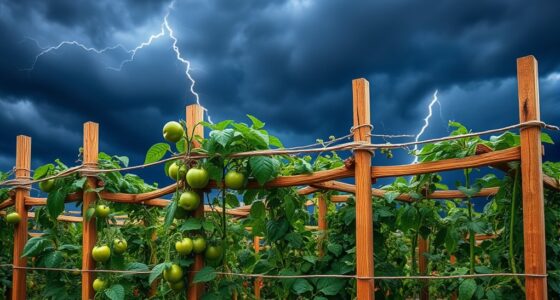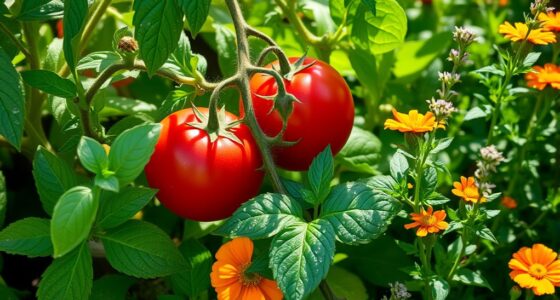Planting cover crops helps you increase soil carbon sequestration by capturing atmospheric CO₂ through photosynthesis and adding it to the soil. Choosing the right species, like legumes or grasses, can boost organic matter, improve soil health, and reduce erosion. Proper management, timing, and minimizing soil disturbance maximize their benefits. If you want to learn how to implement cover cropping effectively for climate and soil health, keep exploring the key practices involved.
Key Takeaways
- Select cover crop species with deep roots and high biomass to maximize soil carbon storage.
- Plant cover crops after harvest or during fallow periods to capture atmospheric CO2 effectively.
- Use no-till or minimal disturbance methods to preserve soil structure and enhance carbon retention.
- Incorporate diverse species like grasses and legumes to improve organic matter and microbial activity.
- Terminate cover crops strategically to maximize biomass decomposition and carbon input into the soil.
Understanding the Role of Cover Crops in Carbon Storage
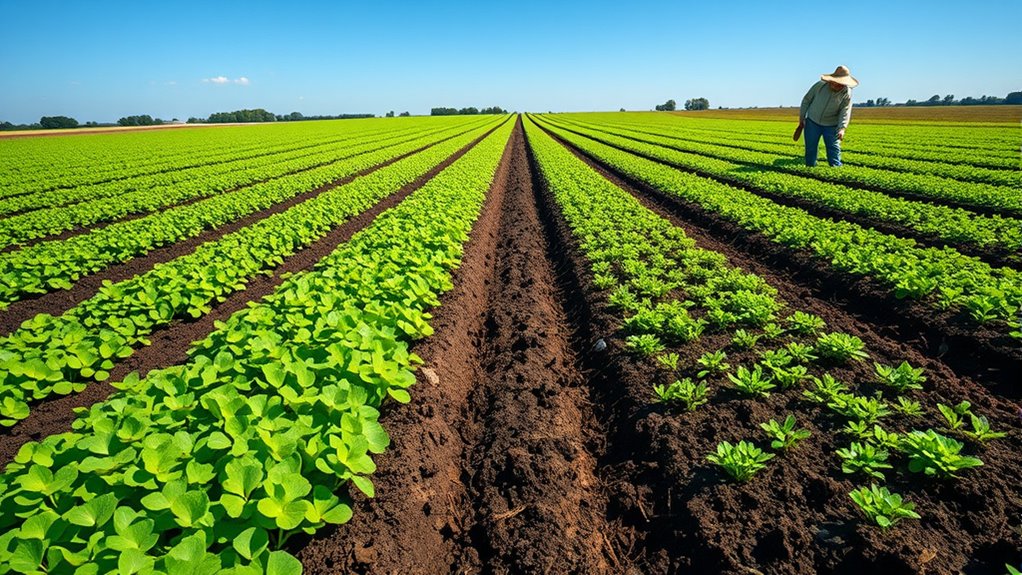
Cover crops play a crucial role in enhancing soil carbon storage by actively capturing atmospheric CO2 through photosynthesis. As you plant these crops, they absorb CO2 from the air and convert it into organic matter. This process not only removes greenhouse gases but also adds carbon directly to the soil, improving its structure and fertility. Cover crops develop extensive root systems that penetrate deep into the soil, stabilizing it and increasing carbon retention below the surface. When you terminate these crops, their biomass decomposes, releasing carbon into the soil where it can be stored for years. This natural cycle helps reduce overall atmospheric CO2 levels while enriching your soil, making it more resilient and productive. Incorporating diverse cover crop species can further enhance soil nutrient absorption and carbon sequestration. Your use of cover crops becomes an essential tool in fighting climate change.
Types of Cover Crops That Enhance Carbon Sequestration
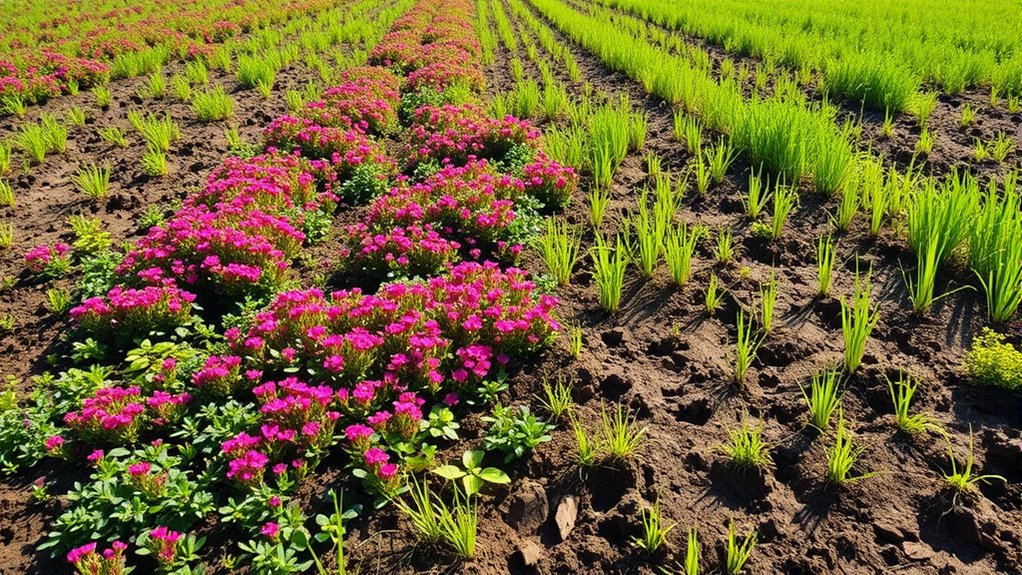
To maximize carbon sequestration, selecting the right types of cover crops is essential, as different species vary in their ability to capture and store atmospheric CO2. Legumes like clover fix nitrogen and add organic matter, boosting soil health. Grasses such as rye and oats develop extensive root systems, increasing soil carbon storage. Brassicas like radishes break up compacted soil, improving aeration and microbial activity. Consider the table below to choose effective cover crops: planting cover crops can greatly enhance soil fertility and carbon capture.
| Cover Crop | Root System | Benefits |
|---|---|---|
| Legumes (clover) | Shallow | Nitrogen fixation, organic matter buildup |
| Grasses (rye) | Deep | Soil stabilization, carbon storage |
| Brassicas | Medium to deep | Soil aeration, pest suppression |
| Vetch | Shallow | Nitrogen fixation, quick cover |
Implementing Cover Crops in Different Farming Systems
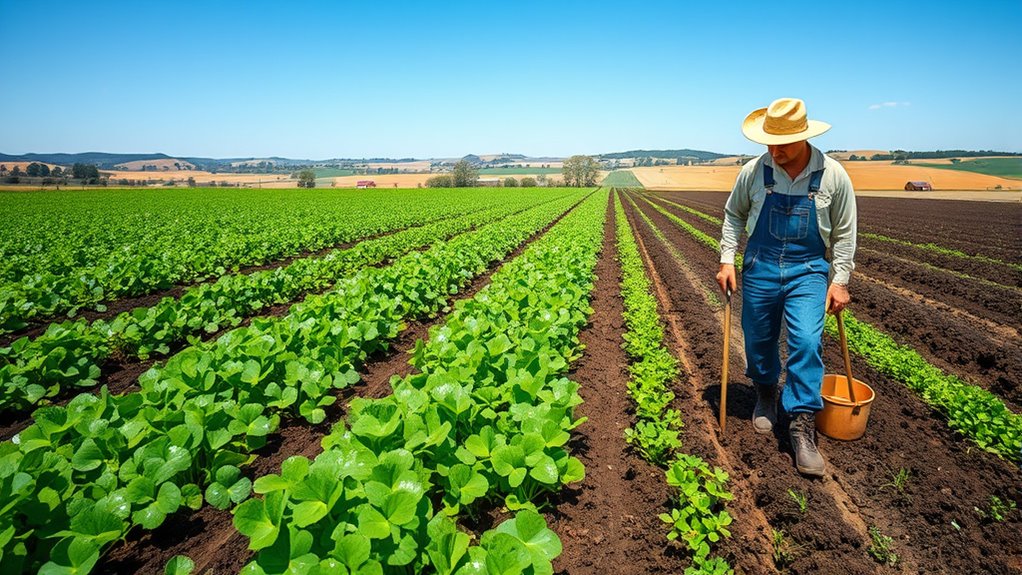
Implementing cover crops effectively depends on your specific farming system, as different practices require tailored approaches. If you’re practicing no-till farming, planting cover crops after harvest minimizes soil disturbance and preserves soil structure. For conventional tillage systems, you may need to incorporate cover crops into your rotation to prevent soil erosion and improve nutrient cycling. Organic farms often integrate diverse cover crops to boost soil fertility naturally, while conventional farms might use specific species to target weed suppression or nitrogen fixation. In irrigated systems, timing and species selection should align with water availability, while dryland farms must prioritize drought-tolerant varieties. Whatever your system, guarantee planting schedules fit your crop cycle, and adapt management practices to maximize cover crop benefits without disrupting your primary production goals. Additionally, understanding how cover crops influence relationships within the soil ecosystem can lead to more sustainable and effective practices.
Benefits of Cover Cropping for Soil and Climate Health

By planting cover crops, you can substantially enhance soil health and combat climate change. Cover crops improve soil structure by increasing organic matter, which boosts nutrient retention and aeration. They prevent erosion, keeping valuable topsoil in place and reducing runoff. These crops also support beneficial microbes and earthworms, fostering a vibrant soil ecosystem. For the climate, cover crops sequester carbon directly in the soil, reducing greenhouse gases in the atmosphere. They also lower the need for synthetic fertilizers and pesticides, decreasing chemical runoff and emissions. Additionally, cover cropping extends the growing season, capturing more sunlight and converting it into stored carbon. Incorporating Kia Tuning techniques can further optimize agricultural machinery for better efficiency and sustainability. Overall, integrating cover crops helps you build resilient, healthier soils while making a meaningful contribution to mitigating climate change.
Challenges and Best Practices for Maximizing Carbon Capture
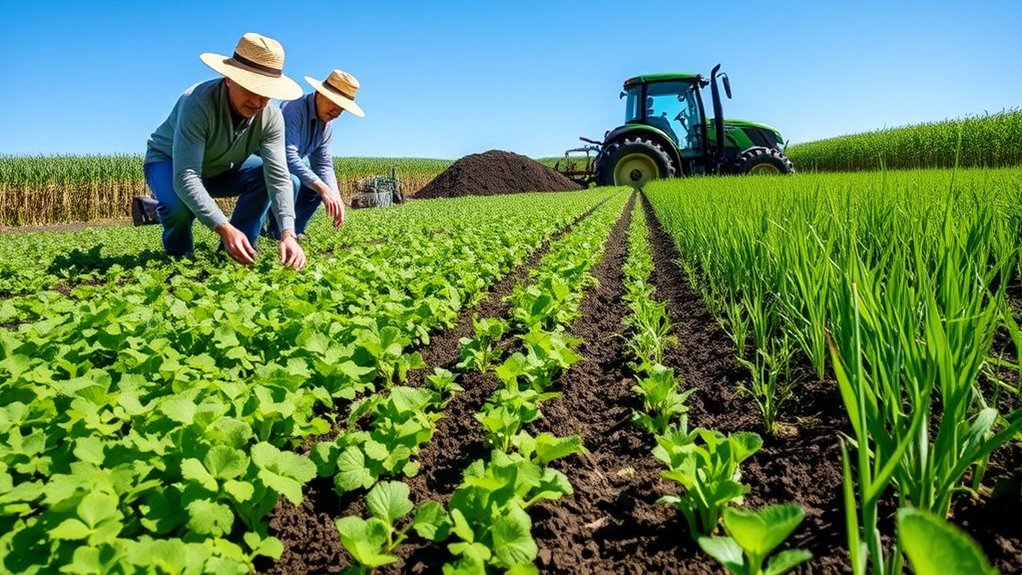
Maximizing carbon capture through cover cropping involves overcoming several challenges that can limit its effectiveness. First, selecting the right cover crop species is vital; some plants sequester more carbon but may not suit your soil or climate. Second, proper timing and termination methods matter—they influence soil health and carbon storage. Third, soil disturbance during planting or tillage can release stored carbon, reducing gains. Fourth, inconsistent management practices across farms hinder ideal results. To address these challenges, focus on using adapted species, plan planting schedules carefully, minimize soil disturbance, and adopt consistent management routines. Implementing these best practices helps guarantee your cover crops contribute effectively to long-term carbon sequestration, boosting soil health and climate benefits. Additionally, understanding the role of innovative planters can enhance planting efficiency and crop success, ultimately supporting your carbon sequestration goals.
Frequently Asked Questions
How Does Cover Crop Diversity Influence Overall Carbon Storage?
You’ll find that cover crop diversity boosts overall carbon storage by promoting varied root systems and organic matter inputs. Different species add unique nutrients and improve soil structure, which enhances microbial activity and carbon retention. When you plant diverse cover crops, you increase biomass and organic matter, leading to more stable carbon sequestration in the soil. This diversity creates a healthier, more resilient soil ecosystem that effectively traps atmospheric carbon.
What Is the Optimal Timing for Planting Cover Crops for Maximum Sequestration?
You should plant cover crops in late summer or early fall, ideally before the first frost, to maximize carbon sequestration. This timing allows the plants to establish roots and grow during the cooler months, which helps lock in more carbon underground. Avoid planting too early in spring or late in winter, as these periods may limit growth and reduce the amount of carbon stored in the soil.
How Do Cover Crops Compare to Other Soil Carbon Enhancement Methods?
Think of cover crops as nature’s vacuum cleaner, pulling carbon from the air and locking it in your soil. Compared to other methods like biochar or no-till farming, cover crops are more versatile and cost-effective, offering continuous benefits. They not only boost soil health but also sequester carbon over time, making them a practical choice for sustainable farming. They work best when integrated into an all-encompassing soil management plan.
Can Cover Cropping Practices Be Adapted for Urban or Small-Scale Farms?
Yes, you can adapt cover cropping practices for urban or small-scale farms by choosing suitable, space-efficient crops like clover or vetch. You should integrate cover crops into your existing planting schedule, using small plots or container gardening if needed. Regularly manage these crops through simple methods like mowing or composting, which helps boost soil health and carbon capture without requiring extensive equipment or large land areas.
What Are the Long-Term Economic Benefits of Planting Cover Crops for Carbon Capture?
You’ll save money over time by planting cover crops because they improve soil health, reduce the need for chemical inputs, and boost crop yields. Additionally, you may benefit from tax incentives or payments for carbon sequestration. These practices can lower your farming costs and increase profitability in the long run, making your farm more sustainable and financially resilient. The investment in cover crops pays off through enhanced productivity and environmental benefits.
Conclusion
By planting cover crops, you boost soil health and fight climate change. While they might require extra effort upfront, the long-term benefits—more carbon stored, healthier soil—far outweigh the challenges. You see, it’s about balancing the work now with the rewards later. As you embrace cover cropping, you’re not just improving your farm; you’re contributing to a healthier planet. It’s a simple choice with powerful, lasting impact.

